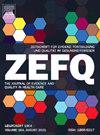Nutzer*innenerfahrung mit allgemeinverständlichen Kurzzusammenfassungen psychologischer systematischer Übersichtsarbeiten mit Metaanalyse („KLARpsy“-Texte) – eine qualitative Studie mit der „Lautes Denken“-Methode
IF 1.7
Q4 HEALTH POLICY & SERVICES
Zeitschrift fur Evidenz Fortbildung und Qualitaet im Gesundheitswesen
Pub Date : 2025-07-01
DOI:10.1016/j.zefq.2025.04.003
引用次数: 0
Abstract
Background
Science communication can support informed decision-making. As part of the “PLan Psy” project, a guideline for producing plain language summaries of systematic reviews with meta-analysis on psychological topics (“KLARpsy” texts), was developed. This study aims to investigate the similarities and differences in the user experience with “KLARpsy texts” between laypersons and professionals (science communicators and psychologists).
Methods
We conducted a qualitative online interview study. Participants read two “KLARpsy” texts presented on a mock-up website and verbalized their impressions and experiences using the think aloud method. The interviews were transcribed verbatim and analyzed with a deductive approach using content analysis.
Results
The study was completed by twelve participants (nine female, three male), including six laypersons, three science communicators, and three psychologists. Both groups found the “KLARpsy” texts to be mainly useful, user-friendly, and trustworthy. Nevertheless, professional users preferred the original studies. Both groups emphasized the need for more detailed descriptions regarding methodology and result presentation. The “KLARsaurus” glossary promoted comprehensibility. The text structure supported usability. However, the structure and transitions between study-specific and general information as well as sentence structure were sometimes seen as non-intuitive. Some opinions on comprehensibility and information density were not consistent within the two groups.
Discussion
The plain language summaries in the form of ‘KLARpsy’ texts were perceived by interested participants as added value for laypersons. Both laypersons and professionals attach particular importance to a transparent and critical, but also understandable and clear presentation of study results. Individual preferences and differences in the perspectives of both user groups highlight challenges of standardizing such a science communication format.
[使用元分析(“KLARpsy”文本)的心理系统评论的简单语言摘要的用户体验-使用出声思考方法的定性研究]。
背景:科学传播可以支持知情决策。作为“PLan Psy”项目的一部分,制定了一项指导方针,用于对心理学主题(“KLARpsy”文本)进行meta分析的系统评论进行简单的语言摘要。本研究旨在探讨外行人和专业人士(科学传播者和心理学家)在使用“克拉普西文本”时的用户体验的异同。方法:采用定性在线访谈研究。参与者在一个模拟网站上阅读两篇“KLARpsy”文本,并使用“大声思考”的方法将他们的印象和经历用语言表达出来。访谈被逐字记录下来,并使用内容分析的演绎方法进行分析。结果:共有12名参与者(9名女性,3名男性)完成了研究,其中包括6名外行人,3名科学传播者和3名心理学家。两组人都认为“KLARpsy”文本主要是有用的,用户友好的,值得信赖的。然而,专业用户更喜欢原始研究。两个小组都强调需要对方法和结果的呈现进行更详细的描述。“KLARsaurus”词汇表提高了可理解性。文本结构支持可用性。然而,研究特定信息和一般信息之间的结构和转换以及句子结构有时被认为是非直觉的。两组在可理解性和信息密度方面的一些观点并不一致。讨论:“KLARpsy”文本形式的简单语言摘要被感兴趣的参与者视为外行人的附加价值。外行和专业人士都特别重视透明和批判性,但也可以理解和清晰地展示研究结果。两个用户群体的个人偏好和观点的差异突出了使这种科学传播格式标准化的挑战。
本文章由计算机程序翻译,如有差异,请以英文原文为准。
求助全文
约1分钟内获得全文
求助全文
来源期刊

Zeitschrift fur Evidenz Fortbildung und Qualitaet im Gesundheitswesen
HEALTH POLICY & SERVICES-
CiteScore
1.90
自引率
18.20%
发文量
129
 求助内容:
求助内容: 应助结果提醒方式:
应助结果提醒方式:


